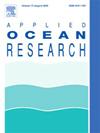Innovative prognostic methodology for pipe defect detection leveraging acoustic emissions analysis and computational modeling integration
IF 4.3
2区 工程技术
Q1 ENGINEERING, OCEAN
引用次数: 0
Abstract
Pipelines play a crucial role in transporting essential resources such as water, oil, and gas across industrial, urban, and environmental infrastructures. Clogging remains a persistent challenge, potentially resulting in catastrophic failures, operational disruptions, increased maintenance costs, and serious safety risks. This study presents a novel prognostic and health monitoring approach that utilizes bubble-induced acoustic emissions to detect and characterize pipeline blockages. An analytical model is developed to capture the acoustic signatures of detaching bubbles, revealing features highly sensitive to clogging. Finite element simulations using Abaqus further investigate how different clogging conditions affect acoustic wave propagation. These insights drive the development of a machine learning-based predictive maintenance strategy, validated on real-world datasets. The results demonstrate exceptional accuracy, with most classifiers achieving 100% detection rates for clogging presence, shape, and severity. Additionally, model generalization tests show that machine learning algorithms adapt more effectively to varying clogging thickness than clogging shape. This research paves the way for a highly accurate, non-destructive monitoring solution, enhancing predictive maintenance and ensuring the reliability of industrial pipelines.
利用声发射分析和计算建模集成的管道缺陷检测的创新预测方法
管道在工业、城市和环境基础设施中运输水、石油和天然气等重要资源方面发挥着至关重要的作用。堵塞仍然是一个持续存在的挑战,可能导致灾难性故障、操作中断、维护成本增加以及严重的安全风险。本研究提出了一种新的预测和健康监测方法,利用气泡诱导声发射来检测和表征管道堵塞。开发了一个分析模型来捕捉分离气泡的声学特征,揭示对堵塞高度敏感的特征。利用Abaqus进行有限元模拟,进一步研究了不同堵塞条件对声波传播的影响。这些见解推动了基于机器学习的预测性维护策略的发展,并在现实世界的数据集上进行了验证。结果显示了卓越的准确性,大多数分类器在堵塞存在、形状和严重程度方面实现了100%的检测率。此外,模型泛化测试表明,机器学习算法比堵塞形状更有效地适应不同的堵塞厚度。这项研究为高精度、非破坏性的监测解决方案铺平了道路,增强了预测性维护,确保了工业管道的可靠性。
本文章由计算机程序翻译,如有差异,请以英文原文为准。
求助全文
约1分钟内获得全文
求助全文
来源期刊

Applied Ocean Research
地学-工程:大洋
CiteScore
8.70
自引率
7.00%
发文量
316
审稿时长
59 days
期刊介绍:
The aim of Applied Ocean Research is to encourage the submission of papers that advance the state of knowledge in a range of topics relevant to ocean engineering.
 求助内容:
求助内容: 应助结果提醒方式:
应助结果提醒方式:


